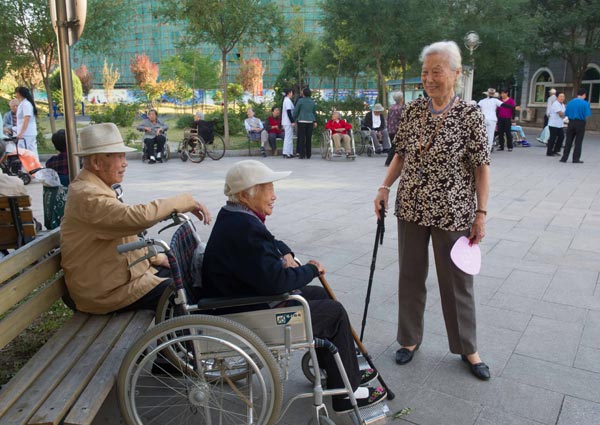

 |
| Senior citizens chat at a retirement home in Beijing. [Photo/Xinhua] |
Monday was the deadline for the pension fund investment plan to solicit public opinion. On June 29, the Ministry of Human Resources and Social Security and the Ministry of Finance jointly issued a draft guideline for managing the basic pension fund and solicited public opinion.
In 2013, the Third Plenum of the 18th Central Committee of the Communist Party of China decided to strengthen the management and supervision of the social insurance fund investment, and facilitate the marketization and diversification of their operations.
Since the State Council advocated deeper reforms of employees' basic pension funds in 1995, China has established a basic pension insurance system. In the first 10 years from 1995, the accumulated fund was limited and, hence, there was not much pressure to increase its value.
The investment system requires pension funds to be deposited in banks or to be used to purchase national debts. But with the gradual increase in the coverage of basic pension insurance and financial subsidies, the consolidation of personal accounts and the introduction of rural and urban social pension insurance systems in the past decade, the scale of urban and rural basic pension insurance funds has increased tenfold, from 326 billion yuan ($52.5 billion), 297.5 billion yuan in urban employees' pension insurance funds and 28.5 billion yuan in rural social pension insurance funds in 2004 to 3.56 trillion yuan, 3.18 trillion yuan in urban employees' pension insurance funds, and 380 billion yuan in urban and rural resident social pension insurance funds in 2014.
The demands of the new era can no longer be met by just depositing the pension funds in banks. The less than 2 percent rate of returns of the banks means more than a 100-billion-yuan loss considering the growth rate of the consumer price index (about 4.8 percent since 1993). Compared with the rate of return of enterprises' supplementary pension funds, 7.87 percent since 2007, the potential loss is more than 300 billion yuan. And compared with the rate of return of the National Social Security Fund (8.38 percent since 2001), the potential loss is over 540 billion yuan. Therefore, to increase the pension funds' value, a diversified and market-oriented investment system is needed.
Pilot programs for reforming the investment system have been adopted over the past 10 years, but they had to be abandoned halfway because of public opinion. Pension funds investment is a difficult issue in social security reform. But if the two ministries' draft is implemented, China can use "Pay As You Go" market-oriented and diversified pension investment reforms and accumulate funds second only to that of Japan.
According to the draft, provinces will act as clients of pension funds investment, and the National Council for the Social Security Fund will be the trustee. The council will sign contracts with different investment managers that will invest in equity assets. The draft also fixes the maximum proportion of investment in equity assets at 30 percent of the net assets, the same as the investment for enterprises' supplementary pension funds but less than that of the National Security Fund (maximum 40 percent).
The overall pension fund is 3.56 trillion yuan, so the maximum funds for investment would be about 3 trillion yuan after reserving a part for pension payments. But in reality only about two-thirds could be turned over to the central authorities, which is about 2 trillion yuan. To reduce its impact on local social and financial development, hundreds of billions yuan are expected to be invested in the early stage, and the rest invested in parts every year. Moreover, after the pension insurance reform of government organizations and institutions, a payment balance of about 500 billion yuan would remain every year, which will go directly to the central trustee the same year.
As the central trustee, the National Council for the Social Security Fund will invest the pension funds, and the hundreds of billions of yuan to be invested are expected to flow into the market every year. But given the different nature of the pension funds, the NCSSF should establish a new risk control and investment management system. Since investing the pension funds is a new challenge for the trustees as well as the external investment managers, there should also be a new management system for the financial market and a new working mechanism for investment managers, the trustee and the provincial clients.
At present, the NCSSF has 18 external investment managers - 16 fund management companies and two security traders. But another 20 external investment managers will be needed after the entrusted pension funds cross the 1 trillion yuan mark.
 Campus belle of Xiamen University gets popular online
Campus belle of Xiamen University gets popular online Who says moms cannot be trendy and hot?
Who says moms cannot be trendy and hot? 10 Chinese female stars with most beautiful faces
10 Chinese female stars with most beautiful faces Stunning photos of China's fighter planes
Stunning photos of China's fighter planes Enteromorpha hits Qingdao coast
Enteromorpha hits Qingdao coast Eight fruits that defend men's health
Eight fruits that defend men's health  First batch of female combat pilots with duel degrees fly Flying Leopard
First batch of female combat pilots with duel degrees fly Flying Leopard Top 10 secrets of longevity
Top 10 secrets of longevity Humanoid robot Yang Yang appears in Shanghai
Humanoid robot Yang Yang appears in Shanghai US sings old tune over radical lawyers
US sings old tune over radical lawyers Taking a paws: 10 cuddly pics of sleeping animals
Taking a paws: 10 cuddly pics of sleeping animals  Villagers cash in on reincarnation interest, govt turns a blind eye
Villagers cash in on reincarnation interest, govt turns a blind eye  Wasteland: How China became the world’s garbage dump
Wasteland: How China became the world’s garbage dumpDay|Week